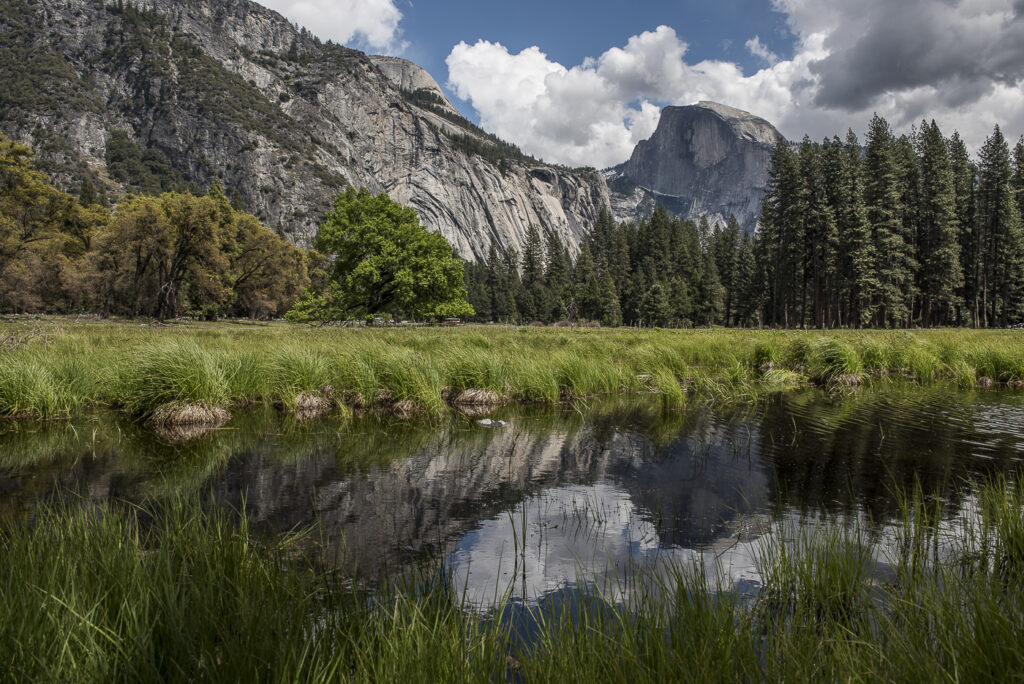Low Impact Tips for Hiking Half Dome
By John P. DeGrazio

Half Dome is the most popular hike in Yosemite National Park and one of the most sought after adventures on the planet. The demand for this hike is so great that the National Park Service began implementing a permit lottery system in 2011 to reduce extreme overcrowding of the trail. A large portion of the Half Dome trail is in Yosemite Wilderness. Having successfully led over 100 summit attempts of this epic journey, I would like to share a Hiker’s Guide to Half Dome in Yosemite National Park with some basic minimum impact guidelines to enjoying the wilderness from our partners at the Leave no Trace Center for Outdoor Ethics.
A Hiker’s Guide to Half Dome in Yosemite National Park
Hiking Half Dome requires a great deal of determination and stamina. If you are one of the lucky ones who have received a permit in the preseason lottery, you have probably begun your training. I highly recommend developing a routine of at least three days per week of cardio as well as some arm strengthening exercises if you have not already. To reach the summit of Half Dome, you will need to hike 16 miles roundtrip while gaining just about 5,000 feet of elevation. In case that wasn’t enough, you will be required to pull yourself up 600 feet of steel cables at the very end. That’s why the arm strengthening will be important. <Insider’s Tip> Do not rely solely on your arms while ascending the cables. Instead, drive off your legs. Sure, they will be tired at this point; but the taxing that your arms will receive will be far greater if you do not rely on your legs. There are more tips for a successful Half Dome summit on the YExplore Hike Half Dome page complete with a gear guide and safety video.
The cable route on Half Dome is expected to be open by May 16 this year. However, there is a possibility of delays since we have received a fair amount of snow at that elevation while storms continue to hit the Sierra Nevada throughout spring. Check the National Park Service website for updated Half Dome information. If you already have your permits, you are good to go. If you were unsuccessful, you may also acquire them through a secondary 48 hour lottery once the season begins.
Hikers Guide to Half Dome in collaboration with Leave no Trace
Leave No Trace is an organization that teaches outdoor ethics for minimal impact uses of our natural lands. It is an important concept to understand. Everyone wants to enjoy nature, but we all can use some education on how to enjoy these beautiful parks and wild lands more responsibly. I have established a much stronger connection to Yosemite since I have been practicing these Leave no Trace ethics and truly enjoy sharing them with visitors from around the world. This summer I will be speaking at several venues on a topic I titled “Fostering Yosemite Stewardship in the Digital Age”, I will be making an appearance at the Sierra Ecosummit on June 11 in Groveland, CA and will speak at REI stores in the Bay Area in September.
Leave No Trace has seven simple common sense ethics to follow. Each is listed below followed by suggested applications to your Half Dome hike.
Know Before you go This is the first rule of any outdoor activity. It’s such a wide ranging topic, but I will share some highlights. First, do your homework. Research the hike, nutrition guidelines, and fitness routines. Make sure you let a friend or family member know your plans and also be certain to check in with a ranger when you arrive in Yosemite. Finally, be sure to pack the right gear. Most importantly, hydrate before the hike and stay hydrated all day, Summer months are hot and dry in the Sierra. Dehydration is one of the last things you want to deal with on this hike.
Choose the right path Yosemite Trail crews spend a lot of time constructing and repairing trails. Please show respect to them and other hikers by staying on trails. Please do not shortcut trails. It causes erosion and also kills the wildflowers and other plant life that struggles to grow in the higher elevation of the Half Dome trail.
Trash your trash Please make sure to pack out any items you pack in. This includes any biodegradable items such as orange peels and apple cores. Although they will eventually decompose, it will take much longer in higher elevations. Also, by leaving this fruit behind, you are introducing a non-natural food source to the wildlife. Other items to consider disposing properly are fruit stickers, corners of wrappers, tissues, and band-aids. I recommend carrying a small bag to trash every item as you consume your calories for the day. Finally, one of the biggest trash problems on Half Dome is the pile of gloves left behind for other hikers. This unwanted trash pile grows almost as high as Sub Dome by the end of summer, and many of them wind up in the stomachs of marmots and squirrels. At last year’s Yosemite Facelift, we removed several full bags of gloves from the cables that weighed hundreds of pounds. Please take them back down the mountain with you.
Leave what you find If you see a beautiful flower, you will want to take a photo of it instead of wearing it in your hair for all to see as you ascend the cables. It’s also a bad idea to take rocks from Half Dome. It’s important for everyone to have the opportunity to enjoy the beauty of this place. The more we remove, the less there is for others to experience. Finally, please do not build rock piles known as cairns on the trails or Half Dome itself. Many people think they are helping by placing them, but even the slightest miscalculation in placement can lead someone down a wrong trail or even off a cliff. I’ve knocked over several misplaced cairns on Sub Dome that pop up all the time and lead hikers dangerously closer to the edge of the rock than they need to be. This has become an issue on the summit as people believe they are “beautifying” nature. Leaving your mark is overrated. Let nature do the work, just enjoy it.
Respect wildlife This is also an easy one to follow. If you stow your trash in a bag in your pack, you are letting wild animals find their own food which is the way nature intended it to be. Please don’t feed squirrels and marmots. Also make sure to zip up your unattended packs and don’t leave them below the cables. I have seen countless backpacks ruined and food stashes lost because they were raided by enterprising squirrels and marmots.
Be careful with fire Please never light a fire on the summit of Half Dome. It is illegal and unsafe.
Be kind to others Unfortunately, this is becoming the most controversial topic of discussion while hiking in nature. When we are in wilderness, we need to realize that what may sound reasonable to you is not reasonable to others. If you like to receive motivation from your music, that does not mean everyone around you would like to as well. Please use your headphones while hiking. Many around you would like to hear the sounds of nature. Bluetooth speakers are not advisable on any hike. There are so many hikers on this trail with diverse taste in music, and what sounds good to you likely will not sound good to others who are trying to share this wilderness experience.
Other ways to be kind to others on the trail is to practice good etiquette like letting the uphill hiker have the right of way and to avoid attempting to pass someone in a narrow or dangerous section of the trail. Practice patience and spend an extra minute to take in the scenery. Finally, my last advice is another <Insider’s Tip> Please use the cables wisely. There are two cables spaced out about four feet apart. It is designed to allow people to ascend and descend at the same time. Unfortunately, these cables become very congested at times, even with the new permit system. Safe passage requires patience from everyone involved. We always recommend getting accustomed to using only one of the cables while ascending. Using the right cable allows the descending hikers an opportunity to safely return to Sub Dome without delay. I have seen many people try to pull themselves up both cables at the same time and can assuredly state this method is not as efficient as using the right cable only. You will not burn out your forearms as quickly and you will attain self sufficiency which means you will not have to rely on waiting for the left cable to become free from others who will be descending. Additionally, it causes extended delays for everyone on the cables. This is no fun when you are stuck in the middle section of the climb which is the steepest. Think about this on a crowded summer day when the cables are full. It should typically take about 15 to 20 minutes to go up or down when everyone is using their own cable. Unfortunately, we have been stuck on the cables for over 45 minutes simply because some hikers do not wish to consider the other hikers. This, of course, is not unreasonable at 8,800 feet above sea level. However, it is something to consider before you begin your hike.
YExplore has produced a safety video on Sub Dome and the Cables that you can watch here:
Half Dome Permits Available From YExplore:
As you may know, YExplore offers guided Half Dome hikes. Below are dates we currently have available and would be happy to help you achieve your goal.
Half Dome day hike permits available: 2017 dates will be announced in mid April.
Half Dome 2 Day/1 Night Backpack Trip permits available: 2017 dates will be announced starting in December.
4 Day/3 Night Backpack Trip with Half Dome Permit: 2017 dates will be announced starting in December.
Thank you and have a safe hike everyone. Always remember to enjoy your Can O Peaches on the summit.




